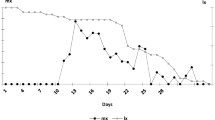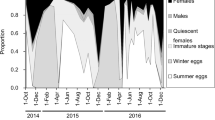Abstract
The life history ofPanonychus akitanus Ehara was studied in two Hokkaido populations on dwarf bamboos. The Sapporo population overwintered both as egg and female adult onSasa senanensis, and the Tomakomai population overwintered as egg onSasa apoiensis. Mites of the Sapporo population produced four or five generations from late April to late November or early December. The eggs that had overwintered began to hatch in mid-May, and this hatching period overlapped with that of eggs laid in late April by females that had overwintered. Therefore, mites with different overwintering stages would interbreed. Most eggs that had overwintered in the Tomakomai population hatched in mid-May, and about four generations were produced before early December, when only eggs were found. The density of mites per leaf of the Sapporo population reached a maximum in early May on old leaves and in late June on new leaves, and thereafter gradually decreased. The Tomakomai population initially decreased in density after hatching in the spring, but rapidly dispersed to new leaves, reached a peak in early September, and then gradually decreased. The maximal density was about 10 times higher and the distribution was less clumped (lower values of the aggregation index,m/m) than that of the Sapporo population. This was probably because the Sapporo mites could utilize only the underside of sporadically distributed leaves which were curled by spiders, whereas the Tomakomai mites inhabited any part of the leaf undersurface of the hairy host plant. Predators observed were phytoseiid mites and larvae of gall midges. The predatory effect on the Sapporo population was not clear. In the Tomakomai population, the number of gall midges correlated with the number of spider mites better than that of phytoseiid mites.
Similar content being viewed by others
References
Akita, Y., 1971. Biological studies of the common conifer spider mite,Oligonychus ununguis Jacobi (Acarina: Tetranychidae). Bull. Gov. For. Exp. Sta., no. 236: 1–25, (in Japanese with English summary).
Andrewartha, H.G. and Birch, L.C., 1954. The Distribution and Abundance of Animals. The University of Chicago Press, Chicago, IL, 782 pp.
Ehara, S., 1978. A new genus and a new subgenus of spider mites from northern Japan (Acarina: Tetranychidae). J. Fac. Educ. Tottori Univ., Nat. Sci., 28: 87–93.
Gotoh, T., 1984a. Ecological studies on diapause of Tetranychinae, with special reference to diapause attributes in relation to host plant phenology. Ph.D. thesis, Hokkaido University, 405 pp. (in Japanese).
Gotoh, T., 1984b. Annual life cycle of the hawthorn spider mite,Tetranychus viennensis Zacher (Acarina: Tetranychidae) on deciduous oak. Jpn. J. Appl. Entomol. Zool., 28: 254–259 (in Japanese with English summary).
Gotoh, T., 1986a. Local variation in overwintering stages ofPanonychus akitanus Ehara (Acarina: Tetranychidae). Exp. Appl. Acarol., 2: 137–151.
Gotoh, T., 1986b. Reproductive isolation between the two forms ofPanonychus akitanus Ehara (Acarina: Tetranychidae). Exp. Appl. Acarol., 2: 153–160.
Helle, W., 1968. Genetic variability of photoperiodic response in an arrhenotokous mite,Tetranychus urticae. Entomol. Exp. Appl., 11: 101–113.
Hoppo Ringyo Kai (Editor), 1982. Distribution of dwarf bamboo. In: Guidebook for Technicians of Forestry in Hokkaido. Hoppo Ringyo Kai (Hoppo For. Soc.), Sapporo, pp. 38–39 (in Japanese).
Iwao, S., 1968. A new regression method for analyzing the aggregation pattern in animal populations. Res. Popul. Ecol., 10: 1–20.
Leinaas, H.P. and Blecken, E., 1983. Egg diapause and demographic strategy inLepidocyrtus lignorum Fabricius (Collembola; Entomobryidae). Oecologia (Berlin), 58: 194–199.
Mansingh, A., 1971. Physiological classification of dormancies in insects. Can Entomol., 103: 983–1009.
Masaki, S., 1973. Climatic adaptation and photoperiodic response in the band-legged ground cricket. Evolution, 26: 587–600.
Masaki, S., 1978. Seasonal and latitudinal adaptations in the life cycles of crickets. In: H. Dingle (Editor), Evolution of Insect Migration and Diapause. Springer, Berlin, pp. 72–100.
Masaki, S., 1980. Summer diapause. Annu. Rev. Entomol., 25: 1–25.
Mori, H., 1961. On the seasonal fluctuation of population of fruit tree red spider mite in Sapporo (Acarina: Tetranychidae). Jpn. J. Appl. Entomol. Zool., 5: 197–202.
Sapporo District Meteorological Observatory, 1982. Hokkaido no kisho. Japan Weather Association of Hokkaido Office Sapporo, Vol. 27, no. 1–12 (in Japanese).
Saunders, D.S., 1976. Insect Clocks. Pergamon Press, Oxford, 280 pp.
Takafuji, A. and Morimoto, N., 1983. Diapause attributes and seasonal occurrences of two populations of the citrus red mite,Panonychus citri (McGregor) on pear (Acarina: Tetranychidae). Appl. Entomol. Zool., 18: 525–532.
Takahashi, K., 1979. Ecological studies on spider mites inhabiting dwarf bamboo and their predacious mites. M.Sc thesis, Hokkaido University 73 pp. (in Japanese).
Tauber, M.J. and Tauber, C.A., 1978. Evolution of phenological strategies in insects: a comparative approach with ecophysiological and genetic considerations. In: H. Dingle (Editor), Evolution of Insect Migration and Diapause. Springer, Berlin, pp. 53–71.
Uchida, M., 1982. Ecological studies on the abundance and diapause of spider mites and the damage caused by the spider mites in Japanese pear orchards. Spec. Bull. Tottori Fruit Tree Exp. Stn. no. 2, 63 pp. (in Japanese with English summary).
Author information
Authors and Affiliations
Rights and permissions
About this article
Cite this article
Gotoh, T. Life-cycle variation inPanonychus akitanus Ehara (Acarina:Tetranychidae). Exp Appl Acarol 2, 125–136 (1986). https://doi.org/10.1007/BF01213756
Accepted:
Issue Date:
DOI: https://doi.org/10.1007/BF01213756




